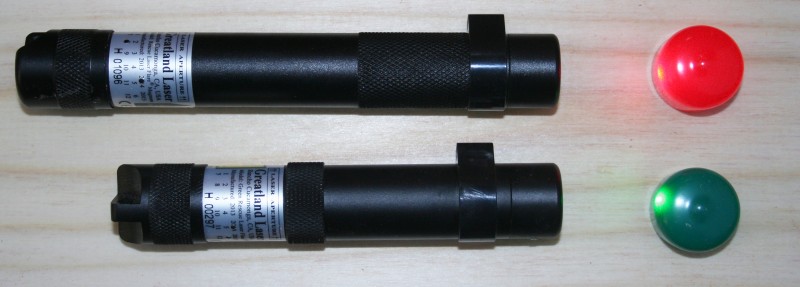 Small Boats Monthly photo
Small Boats Monthly photoThe Rescue Laser Flare Magnum (top) and the Green Rescue Laser Flare (bottom) project a beam that will be seen by your targets as a bright and distinctive flash of light but won’t cause temporary loss of vision or injury.
There are many tools you can use to call for help when you’re on the water: VHF radios, handheld or aerial flares, mirrors, flags, horns, smoke, and dyes. They all have their advantages and shortcomings; in an emergency you’ll want the tool best suited to the job at hand.
Greatland Laser’s Rescue Flares are effective visual distress signals. While pyrotechnic flares can be seen from any direction, they are short-lived and dangerous to handle. A laser has to be aimed, but lasts for hours if not days and is safe when used properly. Greatland’s lasers are available in red and green signals, both of which are the size of small flashlights. The red Magnum uses two common AA alkaline batteries for 72 hours of continuous use, and the Green Rescue Laser Flare has a single CR123 lithium battery good for 5 hours. The life of the flare is virtually unlimited: The laser diodes for the red light are rated for 10,000 hours, the green for 5,000 hours.
Both flares have rugged anodized aluminum housings, vinyl color-coded caps to protect the lens, and available nylon holsters with a webbing belt loop. To use the flare, remove the vinyl cap and simply twist the unit on. A sight ring aids in signaling a target; with the ring at the top, the fan of laser light is oriented vertically. Unlike simple laser pointers, which project a single dot of light, the flares produce a line of light that increases in length moving away from the flare. The green flare projects a beam covering 3°, the red 5°. At 8 miles, the red projects a beam 3,000′ long, and a 6,000′ beam at 16 miles. The spread of the light not only provides compensates for aiming errors, but also makes it safer for those who catch sight of it.
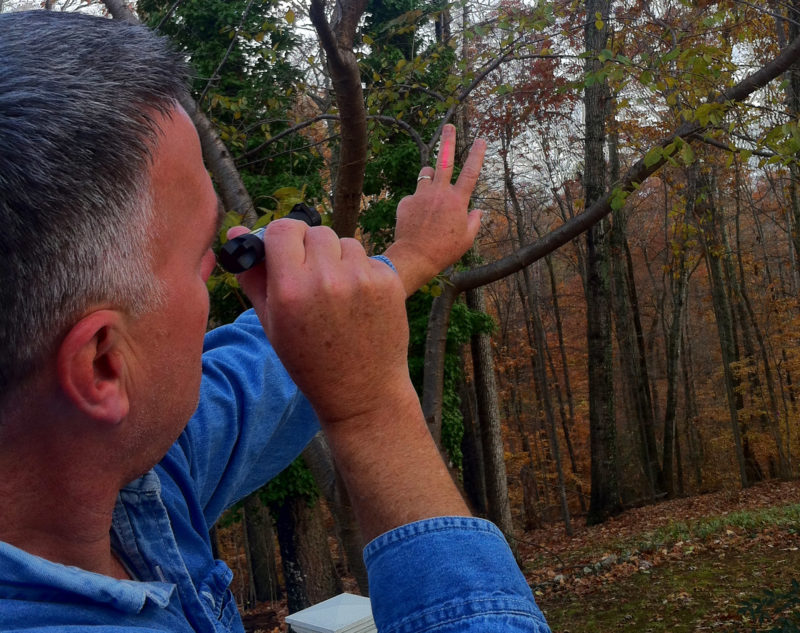 Eddie Breeden
Eddie BreedenThe rescue flares have an integral sighting tube, but it can be difficult to see properly in the dark. To aim the laser without it, hold the flare next to your eye and hold out two fingers with your target in between them. Sweep the beam of light back and forth across your fingers and you’ll hit your target.
Which brings us to a caveat: Greatland Laser warns against viewing the laser at a distance less than 13 feet. Beyond that distance the power of the laser is below the level that can cause injury to eyes. Unlike laser flares, pointer lasers do not fan the light out, and their intensity isn’t radically diminished over distance: The flash of the single beam can temporarily disrupt the vision of pilots and even do permanent damage to their eyes. The light from the laser flares is much less powerful than that of many laser pointers, and yet still distinctive and visible at long distances.
How long? Greatland claims that in normal night conditions the Magnum flare is visible from 20 miles, the Green from 30. As a comparison, typical handheld signal flares offer just 5-mile visibility. Obviously, best distances are given at night, but daylight use is possible too, with a reduction in range, 3 miles for the Magnum, 3 to 5 for the Green.
To make sure there was no chance of the lasers being taken for signaling an actual emergency, we tested the visibility of the flares in broad daylight over a 3-mile distance in an area where the laser wouldn’t be noticed. The 3-mile distance is the maximum rated daylight range for the Magnum and the low end of the Green’s daylight range. When the flares’ beams fanned across us, we saw very brilliant flashes. The green did appear brighter. We were impressed. At night the flashes are even more brilliant.
Greatland rates the Laser Rescue Flares as waterproof to 80′. I tied the flares to a line, turned them on, and lowered them to a depth of 25’ for 15 minutes. I also left the lights, turned off, submerged in a bucket of water overnight. The flares survived both dunkings in good working order.
With the protective caps over the lenses, both of the flares provide a diffuse low-level light for close tasks without degrading night vision. The flares are very effective in locating objects such as buoys, markers, or clothing that are equipped with retroreflective material but be very careful when using the lasers for non-emergency use. While the laser flares produce a brilliant return from retroreflective materials, a bright white flashlight should be your first option for locating markers. Flashlights cast a much wider beam, and you’re likely to find what you’re looking for much more quickly; but, more importantly, a white flashlight is also much less likely to be mistaken for a distress signal and won’t put you at odds with the many and varied local laws restricting the use of lasers.
Keeping a Rescue Laser Flare tethered to your life jacket and at the ready would provide a brilliant, distinctive, and long-lasting emergency signal, a great addition to your survival gear.![]()
Eddie Breeden grew up racing Moths and Lasers and has a bit of offshore sailing— Bermuda and Block Island—to his credit. A native Virginian, he’s an architect, married with four children. As an amateur boatbuilder he has built a Sooty Tern, an Eastport Pram, a cedar-strip kayak and a couple of skin-on-frame kayaks, all described on his blog, Lingering Lunacy.
The Rescue Laser Flare Magnum, $124.95, and the Green Rescue Laser Flare, $299.95, are available from Greatland Laser and their US and international dealers. (When this issue of Small Boats Monthly went live on January 1, the prices listed were for 2014. On January 6 we received word that Greatland Laser had to increase prices for the first time in eight years. The updated prices for 2015 are listed here. —Ed.)
Update, 4/2/19: The price of the Green Rescue Laser Flare has been reduced to $224.94.
Thanks to reader Michael Vetsch for suggesting this review of laser flares. Is there a product for boatbuilding, cruising or shore-side camping that you’d like us to review? Please email your suggestions.
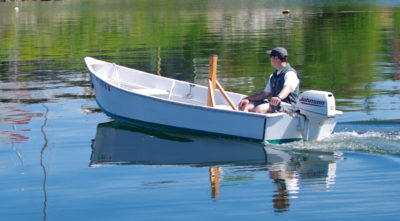
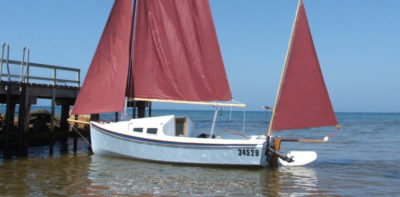
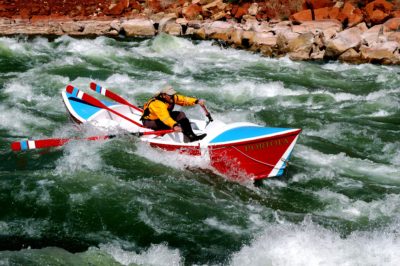
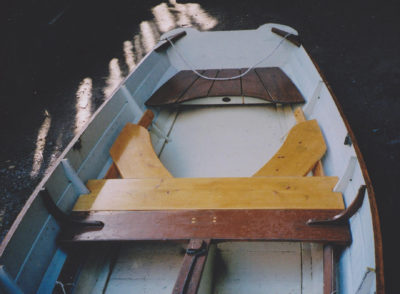
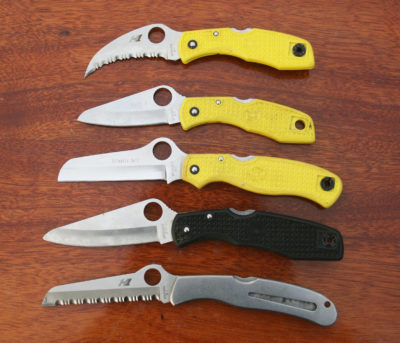
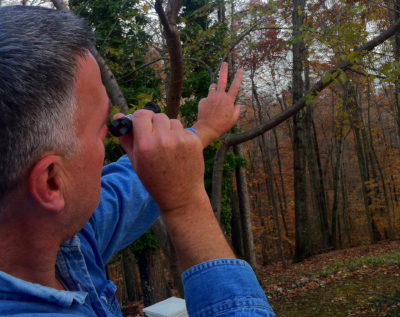
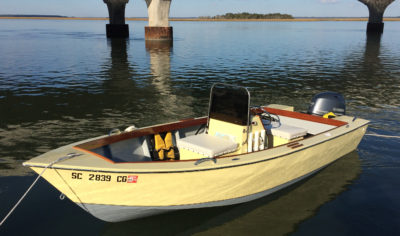
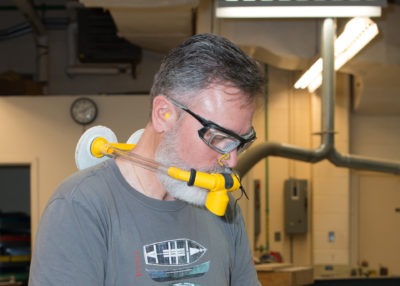
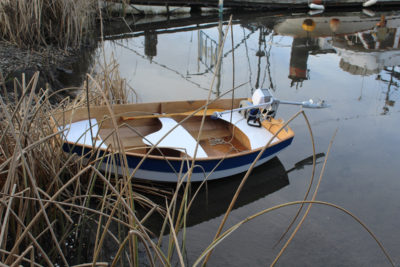
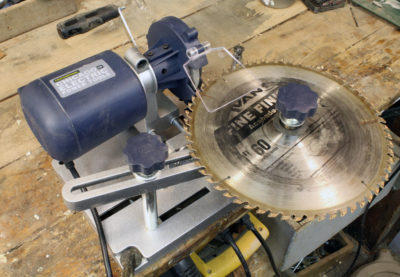
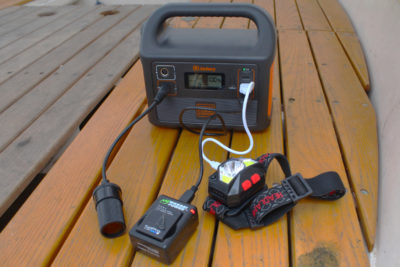
Guides on the Maine coast have been using these since the late 90s, after a demo on a foggy day at the Southwest Harbor Coast Guard station by the then Castine based rep. In the fog they don’t go as far, but they light up particles so you have an immense fan shaped wedge of light. I have a small red one, now discontinued in favor of the green one, and the larger double AA one. Smaller one has lived with out corrosion or other problems in my paddling PFD where it is wet more than dry. The larger one is in the row/sailboat ditch bag. And for the ultimate in coolness, use it carefully instead of a laser pointer when you next need to do a power point talk.
Thanks for the good testimonial there Ben. I had talked with Kim at Greatland. She was very receptive, knowledgeable, and quick to answer my questions. Anyone considering these fine tools should give the company a holler. The red flare has been produced since 2001, the green since 2005. So, a good track record there. Also, it is my understanding that the U.S. Coast Guard is revamping their regulations and such flares are expected to be considered as supplement visual distress aids. These are very good safety additions.
Great blog—Lingering Lunacy—the author has. Worth a look.